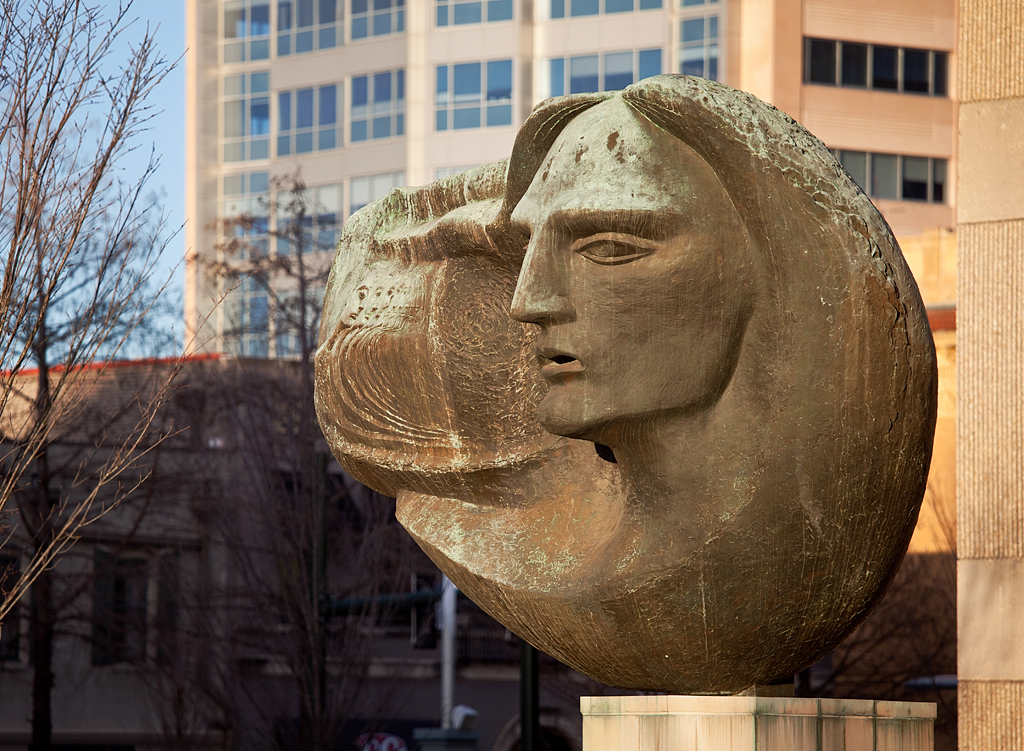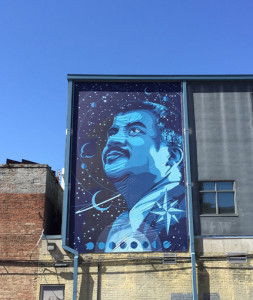
Monumental art of Baton Rouge
Frank Hayden’s 1979 sculpture “Head of Oliver Pollock” at the Galvez Plaza. Courtesy LASM
With downtown beautification and street art, our city’s public art continues to evolve—and it is starting to attract national attention
From curious sculptures downtown to the vibrant street art on decrepit buildings in Old South Baton Rouge, Louisiana Art & Science Museum is taking a look at the history and process of creating these artworks for the city’s public spaces.
The exhibit “Monuments and Metaphors,” opened in late March, taking up much of the first and second floor gallery space in the museum. It features original small-scale studies of some of the iconic sculptures downtown, stained glass works and even a large 3-D printed recreation of a relief on the side of Charity Hospital in New Orleans.
While the exhibit pays a great deal of attention to more traditional, commissioned public art projects (some as early as the 1950s), LASM communications coordinator Douglas Kennedy says the impetus was the guerilla-style street art and graffiti that’s recently emerged in Old South Baton Rouge, as well as murals developed by The Walls Project.
|
|
“Lexi [Guillory], the collections manager, she was noticing all these murals popping up around the city, and thought it might be interesting to do a commentary on what public art was back then and where it’s going today,” Kennedy says.
With preparatory drawings from the artists, tools used by the sculptors and massive photos of the street art you’d otherwise need to scout on your own, the exhibit provides plenty of insights into how such works come together.
A companion exhibit in the nearby Soupçon Gallery pulls from the museum’s vault a 1979 display that examined sculptor Frank Hayden’s bronze casting techniques and pairs it with the more modern techniques of local sculptor Brad Bourgoyne, who uses 3-D printing. Bourgoyne’s process is shown through studies and casts of his 2008 sculpture of Paula Manship, and the final bronze sculpture was borrowed from the Shaw Center for this exhibition.
“This is not your typical art show,” Kennedy says of the combined exhibits. “You’re getting the history; you’re getting the science. It’s really multidisciplinary.”
“Monuments and Metaphors: Art in Public Spaces” and “From Clay to Bronze: Revisited” are on view at LASM until June 28. Find out more at lasm.org.
A shift in public art
During a panel discussion at LASM in late March, artist Samuel J. Corso talked about how public art of the past was often traditional in nature, reflecting the city and its history. “I think now the public art that’s commissioned is much more about self expression … it’s really about a personal statement,” Corso said.
Corso, a Baton Rouge Gallery member and stained glass artist, has commissioned works at St. Joseph Catholic Church and is featured in the “Monuments and Metaphors” exhibit at LASM.

Panelists at the event agreed that the surge of street art here and globally shows a new direction for public art that isn’t driven by committee.
“The reality is that public art can’t be controlled,” The Walls Project’s Casey Phillips said. “It becomes more of a voice of the people that live here. It’s anyone who has rollers and primer and paint and actually has something to say.”
At the panel, Downtown Development District’s Davis Rhorer discussed the newest public art project for the city—a commissioned sculpture on the downtown riverfront near Florida Street that will serve as a “gateway” into the area. The Rotary Club is sponsoring a competition for artists with plans for the chosen sculpture to be completed during Rotary’s 100th anniversary in 2018.
The sculpture is just one component of a beautification project for the Florida Street and River Road intersection, which also includes methods to partially obscure surface parking lots near the riverfront, such as screens that could function as another blank canvas opportunity for artists. Find out more at downtownbatonrouge.org.
Read more about how Google is helping preserve some of Baton Rouge’s street art.
|
|
|

